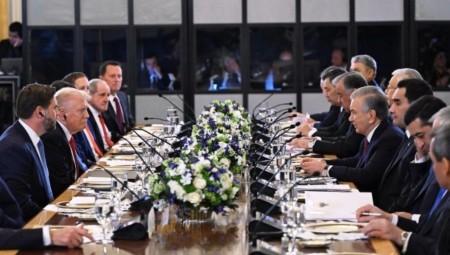Way back in 1890, Captain Alfred Thayer Mahan, a lecturer in naval history and the president of the United States Naval War College, published The Influence of Sea Power upon History, 1660–1783, a revolutionary analysis of the importance of naval power as a factor in the rise of the British Empire.
Mahan argued that British control of the seas, combined with a corresponding decline in the naval strength of its major European rivals, paved the way for Great Britain’s emergence as the world’s dominant military, political, and economic power. Mahan and some leading American politicians believed that these lessons could be applied to U.S. foreign policy, particularly in the quest to expand U.S. markets overseas.
The United States of America considers itself a maritime power and more recently, as an Indo-Pacific nation. The concept of Indo-pacific was first enunciated by the late Japanese leader Shinzo Abe in August 2007. In a speech to the Indian Parliament, he said presciently: "We are now at a point at which the Confluence of the Two Seas is coming into being. The Pacific and the Indian Oceans are now bringing about a dynamic coupling as seas of freedom and of prosperity." Building on the informal cooperation between US, Japan, India and Australia during the Tsunami that hit Asia in 2004, a quadrilateral security dialogue (hereinafter referred to as Quad) was suggested by the late Japanese leader Shinzo Abe in 2007. But by 2008, the initial enthusiasm wore off with both Australia and India at various times expressing reluctance. It took until March 2018 for the Quad to really be institutionalised. Geopolitics was evident when in one of the first reactions to this renewed initiative, the Chinese Foreign Minister then (and now) Wang Yi said it was a “headline grabbing” idea which will “dissipate like sea foam”. Well, the Quad is here to stay and far from dissipating like sea foam has gone from strength to strength, much to the angst of China. More on this later.
It is easy to understand why the Indo-Pacific is important for democratic countries which believe in keeping sealines of communication open and advocate a rules-based maritime order. The region is home to more than half the world’s population, and it accounts for 60 percent of global GDP as well as two-thirds of global economic growth.
Japanese leader Abe’s genius lay in enunciating an integral view of both the Indian and Pacific Oceans by arguing that maritime security is indivisible and inalienable. Of course, for the United States of America, Australia and Japan the Pacific Ocean is the world’s largest and deepest ocean covering more than 30 per cent of the Earth’s surface. The sheer economic importance of this in the form of minerals, oil & gas, fishing grounds etc cannot be overstated. It also matters because of climate and food security. Equally, from a geopolitical perspective, China wants the United States of America out of the Pacific so it can call the shots there. China views the US as an extraneous power which has no business being in the Pacific, which it considers as its own backyard. The US, on the other hand, considers itself as an Indo-Pacific power and recognises the region as vital to its security and prosperity. The United States has expressed determination to strengthen its long-term position in and commitment to the Indo-Pacific. With this in mind, the United States of America intends to focus on every corner of the region, from Northeast Asia and Southeast Asia to South Asia and Oceania, including the Pacific Islands. In a quickly changing strategic landscape, the United States of America believes its interests can only be advanced if it firmly anchors itself in the Indo-Pacific and strengthen the region alongside its closest allies and partners.
India deciding to join and work with Quad countries is a strategic move of great import. It can even be described as the most important geopolitical strategy of India’s since the end of cold war. The reason for this important move must first and foremost be traced to China’s aggressive designs in the region. China believes it is entitled to a permanent maritime presence in the Indian Ocean. This is of recent vintage dating back to 2008. China believes while it is called “Indian Ocean” it is certainly not India’s Ocean! However, it does not admit of the same logic when it comes to South China or East China Sea; it can be argued equally that this is not China’s Sea after all! For India, there is a twin challenge posed by China: one which is maritime and the other which is continental. India cannot allow either the Indian Ocean or the Himalayas to be dominated by China. India knows that in the Himalayas, it must bear the cross all by itself. In the Indian ocean however, India is enlisting help from its partners and friends and has decided on a series of plurilateral or mini-lateral groupings to counter China. This is based on the sober assessment of a significant power differential between China and India.
India is aware that the US and its Western allies are more focused on the Pacific theatre. This has led India to undertake several initiatives of its own in the Indian Ocean. Some of these are: Indian Ocean Naval Symposium which seeks to enhance maritime cooperation among the littoral states of the Indian Ocean region; SAGAR or security and growth for all in region; Colombo Security Conclave involving India, Sri Lanka, Maldives and Mauritius; and the Information Fusion Centre-Indian Ocean Region which enhances efforts to combat maritime security threats. Finally, India is a part of the Indo-Pacific Partnership for Maritime Domain Awareness (IPMDA), a Quadrilateral Security Dialogue initiative that aims to offer an integrated and cost-effective awareness to its members so they can fully monitor the waters on their shores.
All this is to say that, geopolitics will continue to drive strategy of different countries in the all-important Indo-Pacific region.
------------------------------------
Dr. Mohan Kumar, former Indian Ambassador to France and presently Dean/Professor at O.P. Jindal Global University















